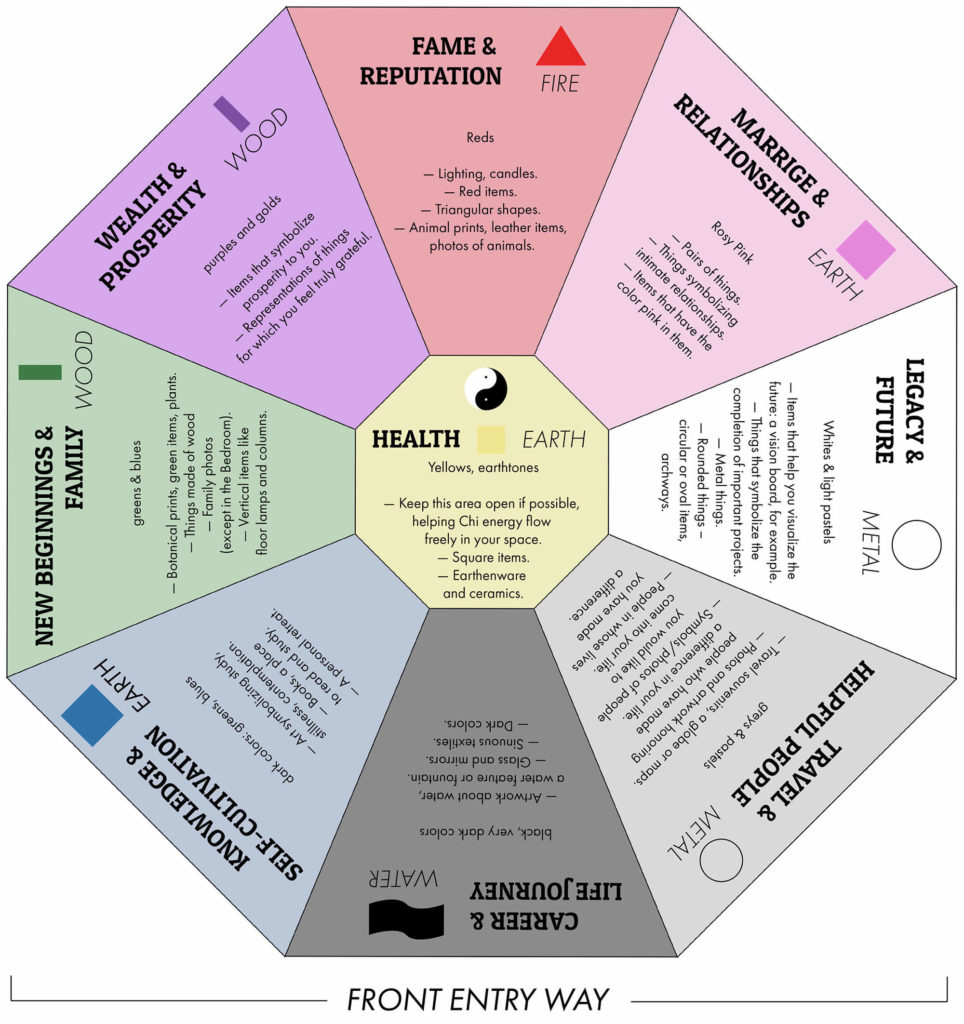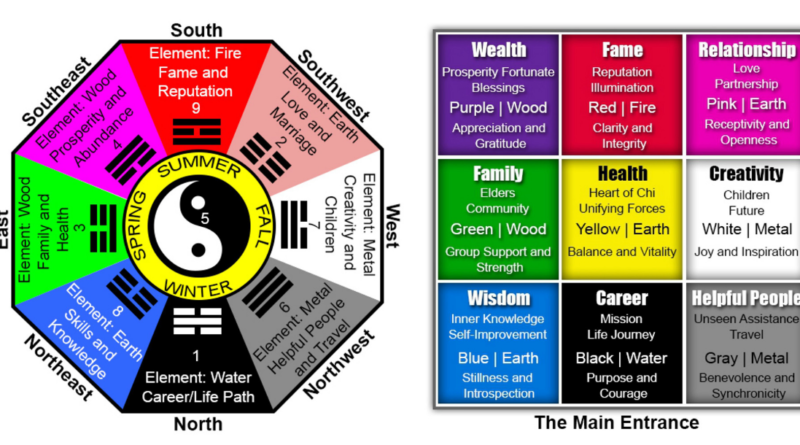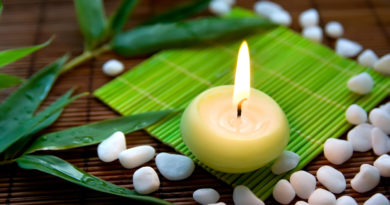FENG SHUI | BAGUA MAP
Bagua (Ba-gua) is one of the main Feng Shui tools used by a Feng Shui master, along with a Luo Pan (feng shui compass) to analyze the Feng Shui energy of any given space and to then, harmonize the place and the elements in it. Translated from Chinese, Bagua literally means “8 areas.”(‘Ba’ means eight (8) and ‘Gua’ means trigram). The Feng Shui bagua is an octagonal map that represents the relation between the different areas in a space with the different aspects of life such as prosperity, fame and reputation, relationships and love, family, health, creativity and children, skills and knowledge, helpful people and travel, and career.

So, the Bagua map divides your living space into nine sections, with eight sections known as “guas” in the eight cardinal directions and a ninth section in the centre. Each of these sections represents one aspect of life and enables you to see the specific relationships between parts of your house (or parts of a room) and the different aspects of your life. Since an octagonal map is not easy to use, the Feng Shui bagua can be represented by a big square divided into 9 smaller squares, arranged in three rows of three.
Though the Feng Shui bagua has a deceptively simple appearance, it is a powerful blueprint for all the changes you wish to enact in order to have a better life. By properly harmonizing each of the bagua areas within your home or working place, you will be harmonizing each area of your life. As an Architect, I have explained the Bagua Map to the best of my understanding under the following headings:
Wht is the eight trigram diagram?
How are the Guas represented in the Bagua diagram?
Describe each of the Guas in the Bagua diagram?
How is the Bagua map used?
WHAT IS THE EIGHT TRIGRAM DIAGRAM?
| SUN (Xun) – (110) Number: 4 Direction: S Element: Soft Wood Family Relationship: Eldest Daughter, women aged between 31-45 Symbology: Wind Body: Hips and Buttocks Group: East Group | LI – (101) Number: 9 Direction: S Element: Fire Family Relationship: Middle Daughter, women between 16 – 30 Symbol: Brightness, Sun Body Part: Eyes and Heart Group: East Group | KUN – (000) Direction: SW Element: Earth Family Relationship: The Mother, Women over the age of 46. Symbology: “Mother Earth” Body:Abdomen, Reproductive Group: West Group |
| CHEN – (001) Number:3 Direction: E Element: Hard Wood Family Relationship: Eldest Son, men between 31 and 45. Symbology: Thunder Body Part: Throat Group: East Group | ICHING -CENTRE (111) Number: 5 Element: Earth | TUI (Dui) – (011) Number:7 Direction: W Element: Soft Metal Family Relationship: Youngest Daughter, girls up to 15 years. Symbology: Marsh Body Part: Mouth area Group: West Group |
| KEN (Gen) – (100) Direction: NE Element: Earth Family Relationship: Boys upto 15, Youngest Son, Symbol: Mountain, Youth Body: Hands, Spine, Small Bones Group: West Group | KAN – (010) Number: 1 Direction: N Element: Water Relationship: Middle Son, men between 16 – 30 Symbol: Water, the Moon Body Part: Liver, Kidneys, Inner Ear Group: East Group | CHIEN- (111) Direction: NW Element: Hard Metal Family Relationship: Father, Men above the age of 46 Symbol: Heaven, Leader Body Part: Head , Brain and Lungs Group: West Group |
HOW ARE THE GUAS REPRESENTED IN THE BAGUA DIAGRAM?
Each of the Guas is symbolised by three Yao symbols, which is equivalent to a bit in today’s binary language. Each Yao represents either Yin (0), female or Yang (1), the male force of nature. Yin (0), female, is represented by two short little hyphens with a gap in between. Yang, male, is one continuous hyphen- like line. For ease, the Yang (male) is symbolised by the number ‘one’ and the Yin (female) is represented by ‘zero’.
DESCRIBE EACH OF THE GUAS IN THE BAGUA DIAGRAM.
Here is the summary of the classical feng shui Bagua. Each of the 9 feng shui areas is associated with a direction/location, a feng shui element, a feng shui colour, a feng shui number and life areas associated with it.
KAN (binary symbol- 010)
Direction: North (compass reading from 337.5 to 22.5) or Front Middle
Feng Shui Element: Water
Colours: Dark Blue and Black
Life Area: Career
Number: 1
CHIEN (binary symbol- 111)
Direction: North-West (compass reading from 292.5 to 337.5) or Front Right
Feng Shui Element: Metal
Colours: White, Black and Gray
Life Area: Helpful People and Travel.
Number: 6
KEN (binary symbol- 100)
Direction: North-East (compass reading from 22.5 to 67.5) or Front Left
Feng Shui Element: Earth
Colours: Beige, Light Yellow, and Sandy/Earthy
Life Area: Knowledge, Education and Spiritual Growth
Number: 8
ICHING ( binary symbol- 111)
Direction: The center of the Bagua is Earth, which in your home, your office or your business signifies YOU.
Feng Shui Element: Earth
Colours: Yellows, Earthtones
Life Area: Health
Number: 5
TUI (binary symbol- 011)
Direction: West (compass reading from 247.5 to 292.5) or Middle Right
Feng Shui Element: Metal
Colours: White, Pastels, metal and Gray
Life Area: Creativity and Children
Number: 7
CHEN (binary language- 001)
Direction: East (compass reading from 67.5 to 112.5) or Middle Left
Feng Shui Element: Wood
Colours: Brown, Green and blue
Life Area: Family
Number: 3
LI (binary symbol- 101)
Direction: South (compass reading from 157.5 to 202.5) or Rear Middle
Feng Shui Element: Fire
Colours: Red, Orange, Purple and bright Yellow
Life Area: Fame and Reputation
Number: 9
KUN (binary symbol- 000)
Direction: South-West (compass reading from 202.5 to 247.5) or Rear Right
Feng Shui Element: Earth
Colors: Beige, Light Yellow, and Sandy/Earthy
Life Area: Relationships and Marriage.
Number: 2
SUN (binary symbol- 110)
Direction: South-East (compass reading from 112.5 to 157.5) or Rear Left
Feng Shui Element: Wood
Colors: Brown, Purple and Green
Life Area: Wealth and Prosperity
Number: 4
HOW IS THE BAGUA MAP USED?
The map is used by placing it over a floor plan of the space being designed or the space that needs to be fixed for problems. You can also enter an existing space – a Site or a House or a Room, – holding the Bagua Map horizontally. With the help of the map, users can pinpoint the areas that need immediate attention so that they can be enhanced by application of Feng Shui principles.
When dealing with a pressing problem, you should first determine which of the nine life guas it fits in. For example, if you are having a fight with your daughter, that would fall into the children gua, whereas dissatisfaction with your salary would relate to the career and wealth guas. After you determine the problem area, overlay the bagua map and see which portion of your home requires an intervention in order to correct the imbalanced energies.
The Feng Shui bagua helps you to understand where you should be making enhancements to improve problem areas and which parts of the home you ought to focus on Individual guas have unique personalities, symbols, and associated elements. When you know about each element and its meaning, the bagua tells you how can you make healing enhancements to your space using one or more elements. Feng Shui study helps you make proper associations between various areas of the home and decorative objects and uses them to bring about healing by correcting the pressing problem.
This post explains the Bagua map and the eight ‘Guas’. Each of the ‘Guas’ is associated with specific colours, shapes and elements. In order to use the Bagua map correctly you need to understand the elements, colours and shapes. Read about them here:
If you found this post useful, I would really love it if you pin it or share it. I have not blocked the site just because your ad blocker is switched on because I hope my content will be useful to you. But I am able to run this site only because of the ads. So I will be obliged if you turn off your ad blocker. Thank you!
Related Topics:
- Feng Shui
- Feng Shui Principles
- Feng Shui Principles Applied To A Proposed Building
- Feng Shui Principles Applied To An Existing Building




Valuable information and excellent design you got here! I would like to thank you for sharing your thoughts and time into the stuff you post!! Thumbs up!
This is a really well thought out post. I certainly enjoyed reading it. Thanks
Quite an interesting article. I invite you all to visit our website to read more about design and Feng Shui at FengShuiatwork.com